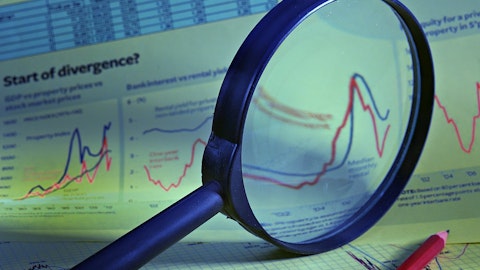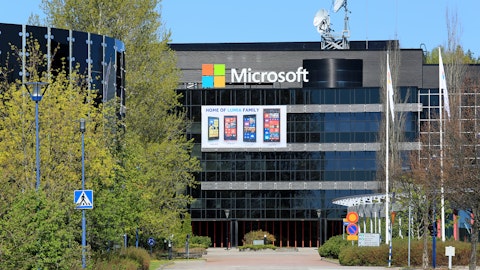In this article, we shall be going over the 5 Biggest SaaS Companies in Europe. If you want to read our detailed analysis of the SaaS sector, go directly to 10 Biggest SaaS Companies in Europe.
5. Amadeus IT Group S.A (BMAD:AMS)
Market Cap as of August 9: $25.7B
Headquartered in Madrid, Spain, Amadeus IT Group (BMAD:AMS) is a Spanish information technology provider for the global travel and tourism industry. At market level, the company operates in over 195 countries through over 173 Amadeus Commercial Organizers (ACOs). In 2011, the company made it at the 985th place on Forbes‘ list of “The World’s Largest Public Companies”. Parented by Amadeus IT Holding S.A, Amadeus (BMAD:AMS) has a primary listing on the Spanish stock exchange. With a total revenue of $2.73 billion in 2021, Amadeus (BMAD:AMS) is one of the biggest SaaS companies in Europe.
Through its cloud-based, centrally located computer reservation software called Amadeus CRS, Amadeus (BMAD:AMS) provides search, pricing, booking, ticketing and other processing services in real-time to travel agencies and providers. It also offers a subscription-based computer software that automates tedious processes like reservations, inventory management, and departure control. Its customers range from hotels, airlines, and tour operators to car rentals and railway companies. In 2010, Amadeus (BMAD:AMS) also launched the Amadeus Hotel Platform using a SaaS model, which is an integrated platform offering a central reservation system, property management and GDS services.
4. Wolters Kluwer N.V. (AEX:WKL)
Market Cap as of August 9: $27.6B
Wolters Kluwer N.V. (AEX:WKL) is a Dutch information services company globally based in Alphen aan den Rijn, Netherlands. Founded through a merger between Kluwer Publishers and Wolters Samson in 1987, the company specializes in legal, business and tax accounting, finance, audit, risk, compliance and healthcare markets. Having more than 19,400 employees in over 150 companies worldwide, the company reported an annual revenue of $4.9 billion in the fiscal year of 2021.
According to a 2019 press release on their official website, Wolters Kluwer’s (AEX:WKL) Finance, Risk and Reporting (FRR) business launched a SaaS Regulatory Reporting solution, marking the first time the company’s OneSumX regulatory software was made available on the cloud. It offers the same functionality as the company’s on-premises product, combining bank data into a single source of data to ensure consistency, ease of reconciliation and accuracy. Furthermore, it includes subscription-based access to the company’s unique Regulatory Update Service which is maintained by Wolters Kluwer’s (AEX:WKL) experts, who actively monitor regulation in over 30 countries. It is a safe and protected platform which provides flexibility of infrastructure for banks which aspire to faster growth.
Furthermore, according to the press release, Wolters Kluwer (AEX:WKL) partnered with Microsoft Azure as part of their SaaS launch to “deliver premium and secure hosting services to its clients, with full platform management service by Wolters Kluwer FRR along with ongoing software upgrades, testing and fixes deployment services.” Today, more than 77% of Wolters Kluwer’s (AEX:WKL) 2021 revenue came from its online SaaS model, making it one of the largest SaaS providers in Europe.
3. Dassault Systemes SE (EPA:DSY)
Market Cap as of August 9: $55.8B
Based in Velizy-Villacoublay, France, Dassault Systemes SE (EPA:DSY) is a French software corporation which specializes in the development of software for 3D product design, simulation, manufacturing and other 3D related products. Employing over 20,000 people in over 140 countries, the company reported a total revenue of $4.97 billion in 2021. The profit-to-equity ratio of Dassault Systemes SE (EPA:DSY) stands at an impressive 70.34 as of August 9. The company is projected to grow by 9.2% over the next year. In recent years, Dassault Systemes SE (EPA:DSY) has been named as one of the ‘World’s Most Innovative Companies’ by Forbes.
Dassault (EPA:DSY) launched its SaaS portfolio in 2012 with the release of its 3DEXPERIENCE platform. It is a subscription-based software application which allows users to create and visualize products and experiences, simulate and test the best possible business solutions in the virtual world, gather and obtain insight from data to optimize product development, and manage data and collaborate with internal and external stakeholders. More than 87% of Dassault’s (EPA:DSY) design, engineering and governance portfolio is available as SaaS on its multi-tenant public cloud offering. Another SaaS application by Dassault Systemes SE (EPA:DSY) is the 3DEXPERIENCE Marketplace which is an online trading platform for 3D digital design, engineering and manufacturing transactions. Furthermore, subscribers can also avail on-demand manufacturing and part sourcing services. Other SaaS offerings by Dassault (EPA:DSY) include Centric PLM, which optimizes fashion and retail; 3DVIA, for 3D home planning; and DraftSight, which facilitates 2D Drafting.
2. Schneider Electric SE (EPA:SU)
Market Cap as of August 9: $75.7B
Headquartered in Rueil-Malmaison, France, Schneider Electric SE (EPA:SU) is a multinational company which specializes in digital automation and energy management. It caters to homes, buildings, data centers, infrastructure, and industries by correlating energy technologies with real-time automation, software and other services. Schneider Electric SE (EPA:SU) is a Fortune Global 500 company which a primary listing on the Euronext Exchange. It also serves as a research company.
Schneider Electric SE (EPA:SU) launched its own cloud-based, SaaS solution in 2018 with the EcoStructure IT for Partners. Infused with predictive analysis, remote monitoring, and lifecycle management capabilities, EcoStructure gives users visibility into customer’s physical infrastructure, which further aids in enhancing performance and reducing cost. It also collects data and assessments from a wide variety of internal and external assets such as uninterruptable power supplies (UPSs), cooling units, intelligent power distribution units (PDUs), physical security and emergency management. It is the first-ever cloud-based data center infrastructure management platform which is specifically designed for solution providers.
In 2021, Schneider Electric SE (EPA:SU) posted a revenue of $29.5 billion, and currently has a PE ratio of 23.48 as of August 9. With over 166,000 employees in over a hundred countries worldwide, Schneider Electric SE (EPA:SU) is one of the biggest SaaS companies in Europe by overall market capitalization.
1. SAP SE (NYSE:SAP)
Market Cap as of August 9: $109.6B
SAP SE (NYSE:SAP) is a German multinational software company based in Walldorf, Baden-Württemberg. It specializes in the development of enterprise software to manage business operations and customer relations. It also sells database software and technology, cloud engineered systems, and other ERP software products. SAP (NYSE:SAP) is the leading ERP software vendor in the world and largest non-American SaaS company by revenue, the world’s third-largest publicly-traded software company by revenue and the second-largest German company by overall market capitalization. In the fiscal year of 2021, the company posted a total revenue of $28.5 billion, and with over 107,415 employees serving more than 425,000 customers in over 180 countries globally, SAP (NYSE:SAP) is the biggest SaaS company in Europe by market capitalization.
In order to pose a greater challenge to competitor Oracle Corp. (NYSE:ORCL), SAP (NYSE:SAP) has started to acquire several companies which sell cloud-based SaaS products since early 2012. As of 2022, SAP (NYSE:SAP) offers a very large array of user-friendly SaaS subscription-based models for its customers including SAP Ariba, SAP Business by Design, and SAP S/4 HANA Cloud, all designed to save cost and time. However, SAP’s (NYSE:SAP) most notable SaaS solution has to be SAP Concur, a provider of cloud-based travel and expense management software, which was acquired by SAP (NYSE:SAP) in 2016 through an aggressive purchase of $8.3 billion, a move which rendered many analysts thoroughly confused. It is SAP’s (NYSE:SAP) most expensive purchase to date. According to reports, SAP (NYSE:SAP) exceeded its revenue projections due to expansion in its SaaS portfolio and the success of SAP HANA. In 2019, SAP (NYSE:SAP) announced plans to terminate the employment of over 4000 employees over plans to shift to more modern cloud-based technologies such as blockchain, IoT, and artificial intelligence.
In their Q1 2022 investor letter, Polen Capital, an investment management firm, alluded to SAP’s (NYSE:SAP) transition into cloud. This is what they said:
“In our opinion, SAP(NYSE:SAP) is demonstrating that their cloud transition and RISE with SAP (NYSE:SAP) strategy are working. We added to our position upon evidence that CEO Christian Klein’s strategy is bearing fruit, and the stock trading down to an attractive valuation during the quarter. The strategy and sell-off are connected, and we believe it provided an opportunity for long- term shareholders. The company recently reported weak 2022 margin and FCF guidance. This was expected if cloud growth accelerated – which it has. Current cloud backlog has accelerated to a mid-20% growth rate, and the S/4 HANA Cloud Backlog and Cloud Sales have accelerated as well. Cloud, which tends to be a very sticky business with high recurring revenue, is now a >$10bn business and represents roughly 40% of sales.
Our research shows this should only increase over the next five years. If management continues to successfully execute its strategy, the transition should create a mechanical lift to margins and greater levels of FCF. We believe SAP (NYSE:SAP) is a durable business led by capable management that is poised to deliver high-quality mid-teens earnings growth over the next five years.”
You can also take a peek at 25 Worst Cities For Allergies and 10 Good Paying Jobs For 18 Year Olds.





